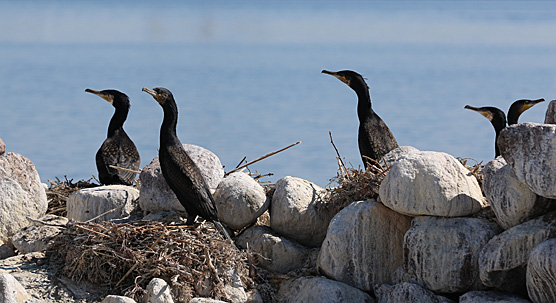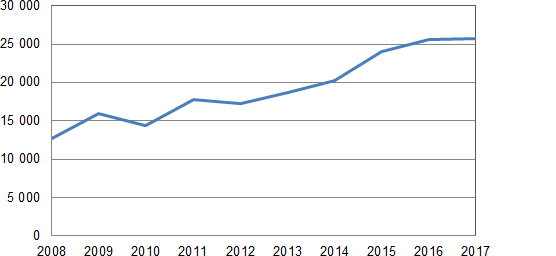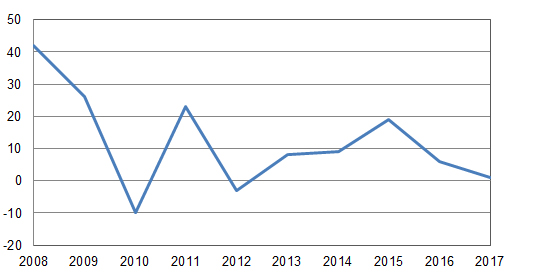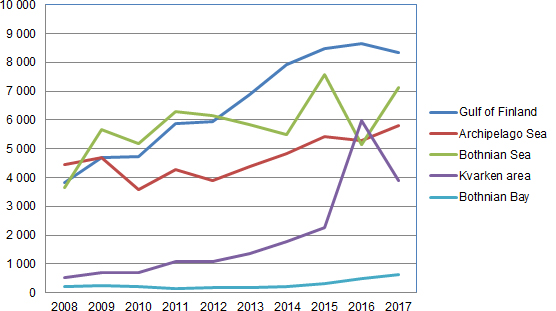Press release 2017-08-03 at 9:27

© Picture: Seppo Knuuttila
A total of approximately 25,750 cormorant nests were counted in the summer of 2017. This means that the cormorant population in Finland’s marine areas only grew by one per cent, or a little over 200 nests, from the previous year, despite the better-than-average weather conditions in the species’ wintering areas. It is likely that the cormorant population is about to reach its natural peak in Finland. The greatest change was the transfer of a largish colony from Kvarken to the northern Bothnian Sea.
Most of Kvarken’s Mustasaari colony, which was illegally disturbed at the early stages of nesting, probably moved to nest in a three-year-old colony in Närpiö. The size of the colony almost tripled from the previous year to some 2,610 nests. As a whole, the population in the Gulf of Bothnia remained roughly unchanged from the year before, comprising about 11,630 nests of which 7,120 were found in the Bothnian Sea, 3,890 in Kvarken and 620 in the Bothnian Bay.
In the Gulf of Finland, the population decreased slightly to about 8,340 nests. In contrast, the population in the Archipelago Sea increased by ten per cent to 5,790 nests, mainly due to the growth of the colonies found in Uusikaupunki and Turku.
Uusikaupunki and Närpiö have the largest colonies
The total number of cormorant colonies found in Finland was 50, which is close to the number in the three previous summers. The colonies nested on 79 islets covering an area of 56 hectares, down by about ten hectares from the previous summer. The largest colonies were found in Uusikaupunki (2,840 nests) and Närpiö (2,610 nests). Other colonies of more than one thousand nests were found in Virolahti, Kirkkonummi, Turku, Rauma, Eurajoki, Pori and Vaasa.
Of the colonies found in the summer of 2016, slightly more than one-third declined and slightly less than one-third increased. Additionally, eight colonies were abandoned and six new colonies were discovered. Of these, nesting was successful in Hanko, Raasepori and Vöyri, and partly in Rauma. It was deduced that the Hanko and Raasepori colonies were formed when a colony ousted from an island with special permission divided and began to nest on two uninhabited islands nearby.
In addition to Mustasaari, nesting was disturbed in Maalahti and Mynämäki. Nesting islets abandoned for an unknown reason during the summer were found in Rauma and Pori.
Numbers of cormorant nests in 2008–2017

© SYKE
Growth of the cormorant population as a percentage in 2008–2017

© SYKE
Colonies concentrated in inner archipelago due to the white-tailed eagle
Increased hunting by the white-tailed eagle in cormorant colonies is affecting nesting results and also the locations of colonies.
“In the Archipelago Sea and the western Gulf of Finland, cormorant colonies have moved closer to the shore during the 2000s. For example, in the outer archipelago in Raasepori, nests have not been found since 2014. In the outer archipelago in Parainen, there were only a few dozen breeding cormorant pairs this summer, compared to the almost 2,500 nests counted five years ago,” says Researcher Pekka Rusanen from the Finnish Environment Institute.
It is more and more common for cormorants to nest in trees in the Archipelago Sea and the western Gulf of Finland, probably due to the white-tailed eagle. In the whole of Finland, the share of tree nests has grown by a couple of per cent per year in the 2010s, and these nests currently account for over one-fourth of all nests. Nesting in trees causes the trees to die within a few years, but the total area of tree-covered islands with cormorant populations is small, less than 20 hectares.
Cormorant population about to reach its natural peak
The slowing growth of Finland’s cormorant population has been examined to determine the natural peak after which the population will stabilise, with some annual variation. According to population modelling performed at the Finnish Museum of Natural History, the peak is likely to be somewhere between 22,000 and 29,000 breeding pairs. However, regional variation in the number of nests in different marine areas can be significant. The denser and larger the cormorant colony, the more internal factors, such as competition, and also hunting by the white-tailed eagle will affect its size.
Cormorant monitoring is conducted so as to obtain basic information on the ecology and spreading of the species in Finland. The cormorant is protected in Finland throughout the year under the Nature Conservation Act, and it is not on the EU’s list of huntable species.
Numbers of cormorant nests by marine area in 2008–2017

© SYKE
Numbers of cormorant nests by region in 2017
Further information
Pekka Rusanen, Researcher, Finnish Environment Institute SYKE,
tel. +358 400 148 691, firstname.lastname@ymparisto.fi
Markku Mikkola-Roos, Senior Researcher, Finnish Environment Institute SYKE,
tel. +358 400 148 685, firstname.lastname@ymparisto.fi
Development of the cormorant population:
Aleksi Lehikoinen, Academy Research Fellow, Finnish Museum of Natural History,
tel. +358 45 137 5732, firstname.lastname@helsinki.fi
Links
Pictures for media